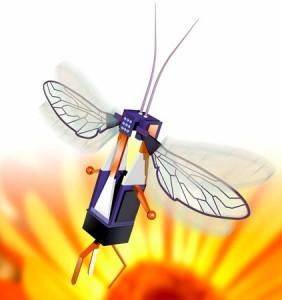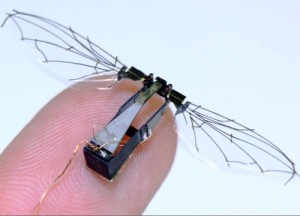In a previous post, Harvard’s work toward developing a tiny robotic fly was discussed. The idea proved interesting enough: small, insect-sized flying robots roughly 1.5 centimeters in length. With enough revision, these robotic flies may even prove useful for more than just breaking new ground in small flight, such as aiding in rescue or gathering intelligence. However, there were several problems. To start, the robots were extremely unstable in their flight, and had to actually be tethered so they could follow a vertical course. They were also energy-inefficient enough to require a cable connecting them to a power source. Harvard is now in the second generation of this project- the robotic bee. Their new ideas have also grabbed the attention of the National Science Foundation, and gained them a ten-million dollar grant in the process.
Since 2007, the launch of their first robot, the Harvard team has been busy. A major aim of the new undertaking for a robotic bee consists of exploring the aerial maneuverability sought after in the original robot, using the first generation’s design as a stepping-stone towards the new robotic bee. They have also set their sights on possible practical uses outside of simple research. Among those possible uses proposed by the Harvard team are robotic pollination of crops, traffic monitoring, military surveillance, and search and rescue. The team will also aim to develop a high-power energy source compact enough to fit on the robot but efficient enough to power it, and to even develop a kind of “hive mentality.”

Robotic Bee Design
Using what will essentially amount to a brain, the scientists aim to install sensors similar to the eyes and antennae of bees on the robot, allowing it to self-monitor its flight. This will also allow it to keep track of its fellow robots and their actions, which will in turn allow for something of a hive mentality capable of communicating and making simple decisions as a group. Essentially Harvard is aiming to set new standards in not only robotics and aerial locomotion, but also to provide new breakthroughs in the computing and programming of complex algorithms, low-energy cost computing, and high-energy power sources compact enough to fit on small machines. Still in-progress, this project may change how scientists and engineers view complex flight.

Harvard's Robotic Fly
Sources:
- NSF awards Harvard $10 million for robot bees video -from learningtongrower’s YouTube channel
- Robobees Home -Harvard Engineering’s home page for the project
- Expeditions in Computing Continue to Break New Ground -National Science Foundation’s page on the 2009 recipients of the American Recovery and Reinvestment Act
Images: